

Transhumanism. Transhumanism (abbreviated as H+ or h+) is an international cultural and intellectual movement with an eventual goal of fundamentally transforming the human condition by developing and making widely available technologies to greatly enhance human intellectual, physical, and psychological capacities.[1] Transhumanist thinkers study the potential benefits and dangers of emerging technologies that could overcome fundamental human limitations, as well as the ethics of developing and using such technologies.
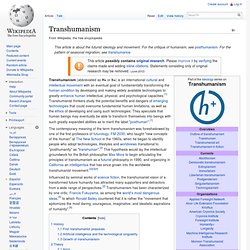
They speculate that human beings may eventually be able to transform themselves into beings with such greatly expanded abilities as to merit the label "posthuman".[1] History[edit] According to Nick Bostrom,[1] transcendentalist impulses have been expressed at least as far back as in the quest for immortality in the Epic of Gilgamesh, as well as historical quests for the Fountain of Youth, Elixir of Life, and other efforts to stave off aging and death. First transhumanist proposals[edit] The 48 Laws of Power. Background[edit] Greene initially formulated some of the ideas in The 48 Laws of Power while working as a writer in Hollywood and concluding that today's power elite shared similar traits with powerful figures throughout history.[5] In 1995, Greene worked as a writer at Fabrica, an art and media school, and met a book packager named Joost Elffers.[4][8] Greene pitched a book about power to Elffers and six months later, Elffers requested that Greene write a treatment.[4] Although Greene was unhappy in his current job, he was comfortable and saw the time needed to write a proper book proposal as too risky.[10] However, at the time Greene was rereading his favorite biography about Julius Caesar and took inspiration from Caesar's decision to cross the Rubicon River and fight Pompey, thus inciting the Great Roman Civil War.[10] Greene would follow Caesar's example and write the treatment, which later became The 48 Laws of Power.[10] He would note this as the turning point of his life.[10]

String theory. String theory was first studied in the late 1960s[3] as a theory of the strong nuclear force before being abandoned in favor of the theory of quantum chromodynamics.

Subsequently, it was realized that the very properties that made string theory unsuitable as a theory of nuclear physics made it a promising candidate for a quantum theory of gravity. Five consistent versions of string theory were developed until it was realized in the mid-1990s that they were different limits of a conjectured single 11-dimensional theory now known as M-theory.[4] Many theoretical physicists, including Stephen Hawking, Edward Witten and Juan Maldacena, believe that string theory is a step towards the correct fundamental description of nature: it accommodates a consistent combination of quantum field theory and general relativity, agrees with insights in quantum gravity (such as the holographic principle and black hole thermodynamics) and has passed many non-trivial checks of its internal consistency.
Quantum mind. The quantum mind or quantum consciousness hypothesis proposes that classical mechanics cannot explain consciousness, while quantum mechanical phenomena, such as quantum entanglement and superposition, may play an important part in the brain's function, and could form the basis of an explanation of consciousness.
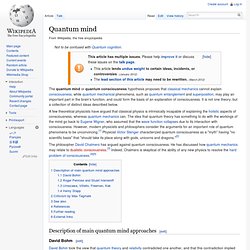
It is not one theory, but a collection of distinct ideas described below. A few theoretical physicists have argued that classical physics is intrinsically incapable of explaining the holistic aspects of consciousness, whereas quantum mechanics can. The idea that quantum theory has something to do with the workings of the mind go back to Eugene Wigner, who assumed that the wave function collapses due to its interaction with consciousness. Neuroscience of free will. Neuroscience of free will is the part of neurophilosophy that studies the interconnections between free will and neuroscience.
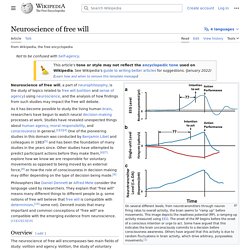
As it has become possible to study the living brain, researchers have begun to watch decision making processes at work. Findings could carry implications for our sense of agency and for moral responsibility and the role of consciousness in general.[1][2][3] Relevant findings include the pioneering study by Benjamin Libet and its subsequent redesigns; these studies were able to detect activity related to a decision to move, and the activity appears to begin briefly before people become conscious of it.[4] Other studies try to predict activity before overt action occurs.[5] Taken together, these various findings show that at least some actions - like moving a finger - are initiated unconsciously at first, and enter consciousness afterward.[6] A monk meditates.
Overview[edit] -Patrick Haggard[6] discussing an in-depth experiment by Itzhak Fried[13] Meisner technique. Meissner effect. Diagram of the Meissner effect.
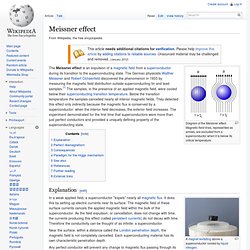
Magnetic field lines, represented as arrows, are excluded from a superconductor when it is below its critical temperature. Golden ratio. Line segments in the golden ratio In mathematics, two quantities are in the golden ratio if their ratio is the same as the ratio of their sum to the larger of the two quantities.
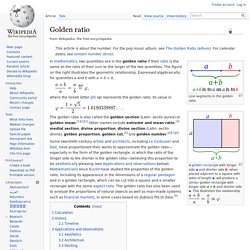
The figure on the right illustrates the geometric relationship. Gödel's incompleteness theorems. Gödel's incompleteness theorems are two theorems of mathematical logic that establish inherent limitations of all but the most trivial axiomatic systems capable of doing arithmetic.
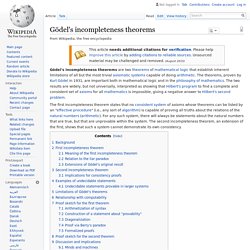
The theorems, proven by Kurt Gödel in 1931, are important both in mathematical logic and in the philosophy of mathematics. The two results are widely, but not universally, interpreted as showing that Hilbert's program to find a complete and consistent set of axioms for all mathematics is impossible, giving a negative answer to Hilbert's second problem.
The first incompleteness theorem states that no consistent system of axioms whose theorems can be listed by an "effective procedure" (i.e., any sort of algorithm) is capable of proving all truths about the relations of the natural numbers (arithmetic). For any such system, there will always be statements about the natural numbers that are true, but that are unprovable within the system. Background[edit] Eternalism (philosophy of time) Conventionally, time is divided into three distinct regions; the "past", the "present", and the "future".

Transcendental Meditation. Recurrent thalamo-cortical resonance. List of memory biases. In psychology and cognitive science, a memory bias is a cognitive bias that either enhances or impairs the recall of a memory (either the chances that the memory will be recalled at all, or the amount of time it takes for it to be recalled, or both), or that alters the content of a reported memory.

There are many different types of memory biases, including: See also[edit] Bose–Einstein condensate. A Bose–Einstein condensate (BEC) is a state of matter of a dilute gas of bosons cooled to temperatures very close to absolute zero (that is, very near 0 K or −273.15 °C[1]). Under such conditions, a large fraction of the bosons occupy the lowest quantum state, at which point quantum effects become apparent on a macroscopic scale. These effects are called macroscopic quantum phenomena. Although later experiments have revealed complex interactions, this state of matter was first predicted, generally, in 1924–25 by Satyendra Nath Bose and Albert Einstein.
Anthropomorphism. Anthropomorphism, or personification, is attribution of human form or other characteristics to anything other than a human being. Examples include depicting deities with human form and ascribing human emotions or motives to forces of nature, such as hurricanes or earthquakes. Anthropomorphism has ancient roots as a literary device in storytelling, and also in art. Most cultures have traditional fables with anthropomorphised animals, which can stand or talk like humans, as characters.
The word anthropomorphism was first used in the mid-1700s.[1][2] The word derives from the Greek ἄνθρωπος (ánthrōpos), "human", and μορφή (morphē), "shape" or "form".